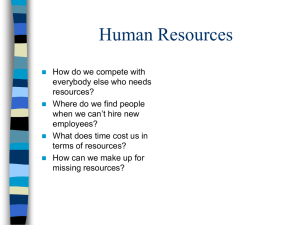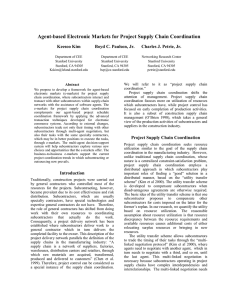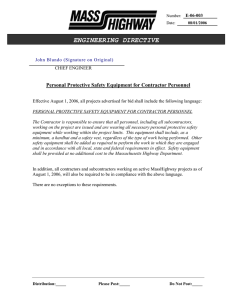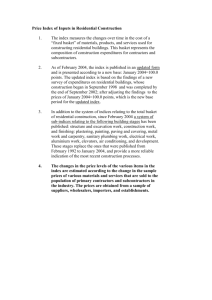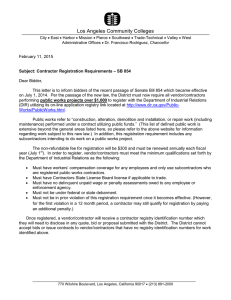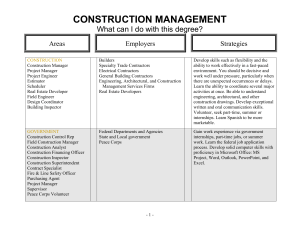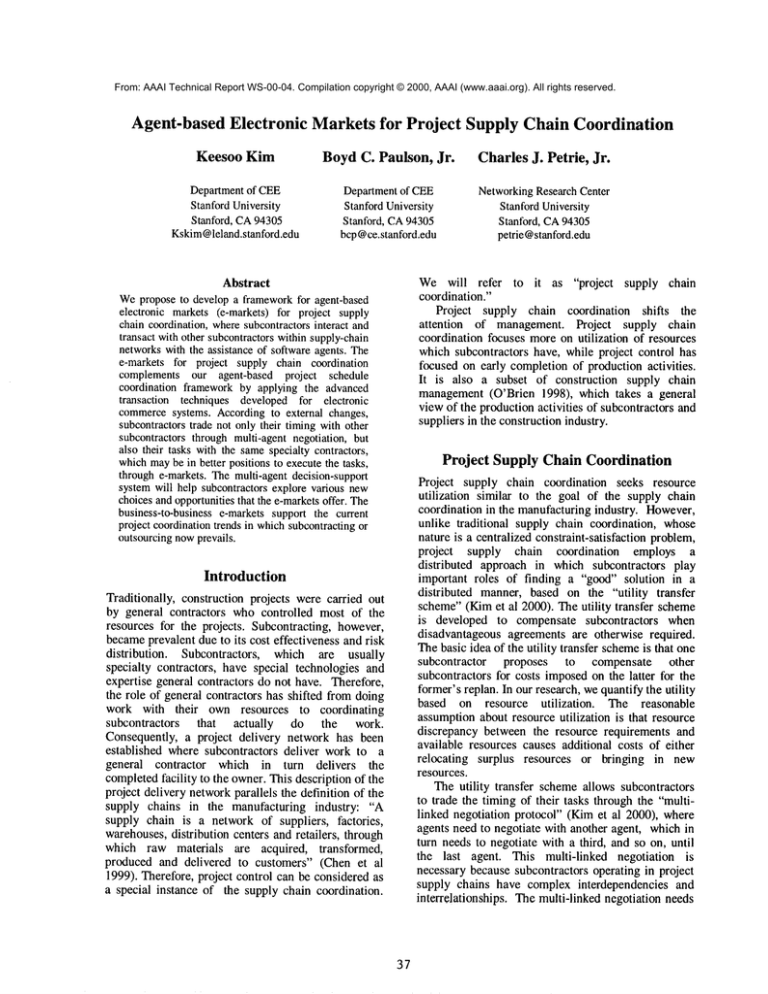
From: AAAI Technical Report WS-00-04. Compilation copyright © 2000, AAAI (www.aaai.org). All rights reserved.
Agent-based
Electronic
Keesoo Kim
Departmentof CEE
StanfordUniversity
Stanford, CA94305
Kskim@leland.stanford.edu
Markets for Project
Supply Chain Coordination
BoydC. Paulson, Jr. Charles J. Petrie, Jr.
Departmentof CEE
StanfordUniversity
Stanford, CA94305
bcp@ce. stanford.edu
Abstract
Wepropose to develop a frameworkfor agent-based
electronic markets (e-markets) for project supply
chain coordination,wheresubcontractorsinteract and
transact with other subcontractorswithin supply-chain
networkswith the assistance of software agents. The
e-markets for project supply chain coordination
complements our agent-based project schedule
coordination frameworkby applying the advanced
transaction techniques developed for electronic
commercesystems. Accordingto external changes,
subcontractorstrade not only their timingwith other
subcontractors throughmulti-agent negotiation, but
also their tasks withthe samespecialty contractors,
whichmaybe in better positionsto executethe tasks,
throughe-markets. The multi-agentdecision-support
systemwilt help subcontractors explore various new
choicesandopportunitiesthat the e-marketsoffer. The
business-to-business e-markets support the current
project coordinationtrends in whichsubcontractingor
outsourcingnowprevails.
NetworkingResearchCenter
StanfordUniversity
Stanford, CA94305
petrie @stanford.edu
We will refer to it as "project supply chain
coordination."
Project supply chain coordination shifts the
attention of management. Project supply chain
coordination focuses more on utilization of resources
which subcontractors have, while project control has
focused on early completionof production activities.
It is also a subset of construction supply chain
management(O’Brien 1998), which takes a general
view of the production activities of subcontractors and
suppliers in the construction industry.
Project Supply Chain Coordination
Project supply chain coordination seeks resource
utilization similar to the goal of the supply chain
coordination in the manufacturing industry. However,
unlike traditional supply chain coordination, whose
nature is a centralized constraint-satisfaction problem,
project supply chain coordination
employs a
distributed approach in which subcontractors play
important roles of finding a "good" solution in a
distributed manner, based on the "utility transfer
scheme"(Kimet al 2000). The utility transfer scheme
is developed to compensate subcontractors when
disadvantageous agreements are otherwise required.
Thebasic idea of the utility transfer schemeis that one
subcontractor
proposes to compensate other
subcontractors for costs imposedon the latter for the
former’s replan. In our research, we quantify the utility
based on resource utilization.
The reasonable
assumptionabout resource utilization is that resource
discrepancy between the resource requirements and
available resources causes additional costs of either
relocating surplus resources or bringing in new
resources.
The utility transfer schemeallows subcontractors
to trade the timing of their tasks through the "multilinked negotiation protocol" (Kimet al 2000), where
agents need to negotiate with another agent, which in
turn needs to negotiate with a third, and so on, until
the last agent. This multi-linked negotiation is
necessary because subcontractors operating in project
supply chains have complex interdependencies and
interrelationships. The multi-linked negotiation needs
Introduction
Traditionally, construction projects were carried out
by general contractors who controlled most of the
resources for the projects. Subcontracting, however,
becameprevalent due to its cost effectiveness and risk
distribution.
Subcontractors, which are usually
specialty contractors, have special technologies and
expertise general contractors do not have. Therefore,
the role of general contractors has shifted from doing
work with their own resources to coordinating
subcontractors
that actually
do the work.
Consequently, a project delivery network has been
established where subcontractors deliver work to a
general contractor which in turn delivers the
completedfacility to the owner. This description of the
project delivery networkparallels the definition of the
supply chains in the manufacturing industry: "A
supply chain is a network of suppliers, factories,
warehouses,distribution centers and retailers, through
which raw materials are acquired, transformed,
produced and delivered to customers" (Chen et al
1999). Therefore, project control can be considered as
a special instance of the supply chain coordination.
37
lateral networks which are usually ignored in the
traditional
supply chains in the manufacturing
industry. The utility transfer schemeand multi-linked
negotiation protocol are the main findings from our
current research about agent-based project schedule
coordination.
The ongoingresearch has shownthat having lateral
networks provides subcontractors opportunities to
explore alternatives to alleviate their losses in cases of
external changes, whichare ubiquitous in construction.
However, the lateral network is confined within the
boundaryof a particular project. Therefore, you might
ask: How can the external lateral
networks be
established outside of project boundary to connect
similar specialty contractors? Whatopportunities can
be explored from interactions through the external
lateral networks? Whatkinds of interaction protocols
are needed
for interactions
among specialty
contractors?
Before proceeding further, we wouldlike to define
some scope and assumptions we made for the this
research: (1) Our research focuses on a particular
construction project managedby a general contractor
that subcontracts most of work; (2) Our research only
considers task re-allocation
problems after
subcontracts are made by the general contractor.
Therefore, our research is different
from the
subcontractor selection process; (3) There are similar
specialty contractors whoare willing to bid for any
task from subcontractors; (4) The similar specialty
contractors are tied with the general contractor.
Therefore, they are pre-qualified for the tasks and only
price is a factor.
Under the aforementioned
assumptions,
we
envision that having the external lateral networks will
allow subcontractors to use market-basedprotocols to
trade their tasks with similarly specialized contractors,
which maybe in better positions to execute the tasks.
Allowing task re-allocation helps subcontractors to
minimize their damage while other specialty
contractors haveopportunities to utilize their available
resources. This will lead to enhancementof global
resource utilization in the construction industry.
Such transactions on the external lateral network
might violate current binding contracts. The benefits
of non-binding contracts were examined through the
de-commissioning in the context of multi-agent
systems (Sandholm and Lesser 1996). Sandholm and
Lesser also claimed that de-commissioning contracts
produces better results than the binding contracts by
allowing agents to explore and exploit opportunities
that do not exist in the binding contracting practices.
Therefore, one of our research goals is to examinethe
benefits of relaxing binding transactions in project
supply chain coordination.
Through transactions outside of project supply
chains, the outside specialty contractors could be
suppliers to subcontractors in project supply chains if
the tasks are a part of subcontracts. In this way,these
transactions
form dynamic supply chains where
specialty contractors come in and leave whenever
transactions are beneficial for both subcontractors and
specialty contractors.
It should be noted that our approach to project
supply chain coordination is different from research
about modeling and analysis of supply chains. We
are proposing a new way of coordinating supply chain
partners, rather than studying coordination issues
amongmultiple entities in supply chains.
Agent-supported
Project Supply Chain
Coordination
The key opportunity for project supply chain
coordination is the emergenceof the Internet and the
World-Wide-Web (WWW). As the WWW
evolves
and expands to include more business-to-business
transactions, information sharing and the level of
integration of activities between the supply-chain
partners will increase.
This new complexity
necessitates new approaches to decision-support and
information management in order to build highly
flexible, fast, secure, and reliable systems that can
allow subcontractors to take advantage of the new
opportunities.
Software agents are atomic software entities
operating on behalf of humans or machines (Moses
1999); software agent technology has been used to
automate several of the most time-consumingtasks on
many occasions (Maes, Guttman, and Moukas1999).
We envision that software agents can help
subcontractors
utilize web-based supply chain
coordination. Through our proposed research, the
functionality of the project supply chain coordination
will be transformed to constructing a virtual supply
chain in a multi-agent system through the negotiation
process among software agents. The currently
developing multi-agent system will allow software
assistant agents to evaluate the impact of their changes
and advise the human subcontractors.
Another
functionality resulting from the dynamic nature of
project supply chain coordination will be addedfor the
new multi-agent system for project supply chain
coordination.
Our agent-supported supply chain coordination
approach should be differentiated
from modeling
supply chain dynamics with a multiagent approach
(Swaminathan, Smith, and Sadeh 1998), where
software agents model humanbeings or organizations
and are used for simulation. Their use of software
agents is perfect for social science, which studies
behaviors of humanbeings and organizations, but
agent-supported systems for engineering applications
should take advantage of software agents that are
capable of handling complex interactions between
38
different entities and the multi-tiered structure of
supply chains, whichis not realistic in humansettings.
Agent-based
e-Markets for Project
Chain Coordination
Research
Objectives
Weare proposing to develop agent-based e-markets
for dynamic project supply chain coordination. The
multi-agent e-markets will be developed to simulate
the dynamic situation that a project supply chain
coordination system encounters, which requires
subcontractors to organize the project supply chain
flexibly.
Specifically, the objectives of this research are to
define a negotiation protocol for e-markets, to define
an e-market ontology, and to develop a prototype for a
multi-agent e-market
Supply
Electronic commerce (e-commerce) can reshape the
methods of agent-based project supply chain
coordination as it has been doing for supply chain
coordination in manufacturing (Zeng and Sycara
1999). E-commerceopens up new opportunities for
subcontractors by allowing them to more easily trade
their tasks in order to make the best use of their
available resources. Furthermore, as transaction costs
decline, new types of transactions, such as auctions,
becomefeasible for trading tasks between specialty
contractors.
Also, the transactions amongspecialty contractors
can be streamlined based on the marginal cost
approximation (Sandholm 1993): "the marginal costs
of a task to an agent is the cost of the agent’s solution
with the task minus the cost of the agent’s solution
without it" (Sandholm1996, p. 80). Therefore, the
marginal cost of a subcontractor will be the highest
desired price for the tasks it wants to sell and the
marginal cost of a specialty contractor will be its
lowest desired price. The specialty contractor will
decide its bid price according to an auction type the
subcontractorset.
Agent-based e-markets leverage agent technology
to facilitate
task reallocation among specialty
contractors, resulting in e-markets for agents. Through
transactions on the e-markets, agents will form and
reform supply chains dynamically such that e-markets
will produce a better solution. Througha preliminary
survey, we discovered that current internet-based
online auctions, such as eBay (www.ebay.com)and
Onsale (www.onsale.com), do not support agent-based
e-markets. Weidentified some examples of agentmediated e-commerce systems which can be used for
our e-markets, based on the survey of e-commerce
agent technology (Maes, Guttman, and Moukas
1999): AuctionBot (www.auction.eecs.umich.edu),
MIT
Media
Lab’s
Kasbah
(www.kasbah.media.mit.edu),
and
t~te-a-t~te
(www.ecommerce.media.mit.edu/tete-a-tete/). To the
best of our knowledge, AutionBot is the only auction
server that allows software agents to bid and create
auctions.
For the proposed agent-based e-markets, the
research questions are: How can agent-based emarkets help subcontractors trade their tasks with
similar specialty contractors outside of the project
supply chains? Howcan agent-based e-markets help
subcontractors organize dynamic project supply
chains?
Research
Approach and Plan
The main research focus is how to coordinate
subcontractors in supply chains dynamically and
flexibly through the agent-based e-markets such that
work can be delivered at the right time in a costeffective manner. This research will be conducted in
four phases. The goals of this research will be to
design the functionality of agent-based e-markets and
to evaluate the results from simulation of case
exampleson a prototype of e-markets.
Phase 1: Multilateral Negotiation Protocol for
e-Markets
The main negotiation technique for e-market will be
determined by the characteristics
and number of
negotiating agents. The specialty contractors outside
of the project
supply chain do not have
interdependencies or interrelationships as muchas
inside project supply chain partners have. This
characteristic makes our multi-linked negotiation
protocol less practical.
However, the number of
specialty contractors is too large to employpractically
the simple bilateral negotiation protocol. Therefore, a
multi-lateral negotiation protocol, whichis also called
an auction protocol, is well suited to e-markets for
trading tasks. The choice of appropriate auction types,
i.e., "English," "Dutch,"or "First-price sealed bid," is
left to the subcontractors.
For the auction, we will adopt a third-party
negotiation protocol (Chen et al 1999). As shown
Figure 1.
lnform~N
epl
~tify
~
Reje¢
Figure 1. Third-party negotiation (auction) protocol
39
Therefore, a small set of pre-defined messages
between the participating agents will be defined to
emulate all the commonauction types. According to
the third-party negotiation protocol, one subcontractor
agent (seller) starts the negotiation by sending
messageto the auctioneer. This message includes the
tasks that it wantsto sell, the highest desired price, and
the preferred auction type. After receiving the
message, the auctioneer will broadcast it to the
specialty contractor agents (bidders) and will organize
an auction according to the requirements the seller
submits. After several rounds of conversation, the
negotiation process will end with a deal that was
reached between seller and bidders. It is the
auctioneer’s responsibility to notify both the seller and
bidders of the winnerand losers.
As it is assumedthat specialty contractors are in
the list of authorized specialty contractors maintained
by the general contractor, the agents representing
specialty contractors are also assumedto be validly
authorized for making a deal. However,the deal is
just a recommendation. Humancontractors always
have to approvethe deal. Therefore, this is a two-step
process, involving contingent commitmentin the first
stage, and final (human-approved)commitmentin the
second stage (Nwanaet al 1998).
Agent-basedProject SupplyChain
[
........... ~,,...~Z~2~.~--:.~.e_.:::.L~
.. ...................................
!
i
1
i
Agent-basede-market(Iw(tp~ed)
E-market
Figure2. Agent-based
e-MarketFramework
simple multi-agent prototype will be built to test
viability of this framework.
This new multi-agent system will be implemented
through the incorporation of the AuctionBot, an agentmediate e-commerce server, which was developed at
the Artificial Intelligence Laboratory (AIL) of the
University of Michigan, into our currently developing
multi-agent system built on top of the ProcessLink
(www.cdr.stanford.edu/ProcessLink/),
which was
developed at the Center for Design Research (CDR)
Stanford University, as shownin Figure 3.
Phase 2: e-Market Ontology
The proposed research focuses on task reallocation
amongspecialty contractors. Task reallocation is
different from schedule coordination problems in
terms of its need of an ontology. In schedule
coordination problems, abstract information, such as
earliest start time, is enoughfor negotiation. In task
reallocation, the ontology about tasks to be traded
should be defined for transactions amongsoftware
agents. By this we mean the specification of the
knowledge structures used to define tasks and the
relationships amongthese tasks (Albers et al 1999).
While defining our e-market ontology for tasks
according to criteria such as clarity, coherence,
extendibility, minimal encoding bias, and minimal
ontological commitment (Gruber 1995), we take
significant advantages of reducing the scope of the
ontology because our agents are grouped based on
their specialties,
which need to be defined as
ontologies.
Figure 3. Agent-basede-Market architecture
Since the AuctionBot provides TCP/IP interface
for software agents (Wurman, Weilman, and Walsh
1998), our agents on ProcessLink can access to
include AuctionBot into our multi-agent e-market
systemfor project supply chain coordination.
Phase 4: Verification and Evaluation
¯ The multi-agent prototype system will be used to
perform the Charrette test (Clayton, Kunz, and Fischer
1998), which is used by the Center for Integrated
Facility Engineering (CIFE) at Stanford University
test the effectiveness of software systems. The subjects
of the preliminary test will be graduate students of
CEEdepartment at Stanford University.
After the analysis of the preliminary test, the main
test will be conducted with the involvement of an
industry group. The Charrette Test will be conducted
Phase 3: Prototype for Multi-Agent e-Market
The multi-agent decision-support framework will
consist of agents which implement functionality of
project supply chain coordination, and an auctioneer
whichspecializes in auctions, as shownin Figure 2.
All agents understand the e-market ontology, bid
according to the auction’s multi-lateral distributive
negotiation protocol, and use the KnowledgeQuery
and Manipulation Language (KQML)to converse.
40
to compare two processes: one is a conventional
"manual" process and the other is an innovative
computer-aided process. The variables to be tested
will be the usability, speed, and accuracy of the
prototype system.
Expected
KimK.,; Paulson, B. C.,; Petrie, C. J.,; and Lesser, V.
R. 2000. Compensatory Negotiation for Agent-Based
Project Schedule Coordination. In Proceedings of the
Fourth International
Conference on Multiagent
Systems. Los Alamitos, Calif.: IEEEComputerSociety
Press. Forthcoming.
Contributions
Maes, P., Guttman, R. H., and Moukas, A. G. 1999.
Agents That Buy and Sell. Communications of the
ACM,42(3):81-91
The proposed research will add a distributed
coordination model for construction supply chain
management.Webelieve that it is the first effort to
model an e-market for specialty contractors in the
construction industry with a multi-agent systems
framework.
It is expected that our frameworkwill create a new
business model for trading tasks among specialty
contractors, which we will refer as "lateral markets"
comparedto the traditional "vertical markets" between
general contractors and specialty contractors as well as
between specialty contractors
and suppliers.
Therefore, this lateral market framework can be
extended to respective
e-markets for general
contractors and for suppliers. While we use the term
"task," the items to be allocated can be resources as
well if the ontologyfor the resource modelis defined.
It is expected that our research will provide a
foundation to develop a project supply chain
coordination system that allows subcontractors to
identify and analyze their resource constraints in a
given schedule, and helps them explore and exploit
manyalternatives for a better solution.
Moses Ma.
1999. Agents in E-commerce.
Communicationsof the A CM, 42(3):78-80
Nwana,H. S., Rosenschein, J., Sandholm,T., Sierra,
C., Maes, P., and Guttmann, R. 1998. Agent-Mediated
Electronic Commerce:Issues, Challenges and Some
Viewpoints.
In Proceedings of the Second
International Conference on AutonomousAgents, 189196. NewYork, NY: ACMPress.
O’Brien, W. 1998. Capacity Costing Approaches for
Construction Supply-Chain Management.PhDThesis,
Dept of Civil and Environmental Engineering,
Stanford Univ.
Sandholm, T. 1993. An Implementation of the
Contract Net Protocol Based on Marginal Cost
Calculations. In Proceedingsof the Eleventh National
Conferenceon Artificial Intelligence, 256-262. Menlo
Park, Calif.: AAAIPress.
Sandholm, T. 1996. Negotiation
Among SelfInterested Computationally Limited Agents. PhD
Thesis, Dept of Computer Science, Univ. of
Massachusetts at Amherst.
References
Albers, M; Jonker, C. M.; Karami, M., Treur, J. 1999.
An Electronic Market Place: Generic Agent Models,
Ontologies and Knowledge, In Proceedings of Agents
99 Workshop on Agent Based Decision-Support for
Managingthe Internet-Enabled Supply-Chain, Seattle,
Washington. 71-80.
Sandholm, T. and Lesser, V. 1996. Advantages of a
Leveled Commitment Contracting Protocol. In
Proceedings of the Thirteenth National Conference on
Artificial Intelligence, 126-133. MenloPark, Calif.:
AAAIPress.
Swaminathan,J. M., Smith, S. F., and Sadeh, N. M.
1998. Modeling the Dynamics of Supply Chains: A
Multi-agent Approach. Decision Sciences. 29(3):607632..
Chen, Y.; Peng, Y.; Finin, T.; Labrou, Y.; Cost, S.;
Chu B.; Yao, J.; Sun, R.; and Wilhelm, B. 1999. A
Negotiation-Based Multi-Agent System for Supply
Chain Management. In Proceedings of Agents 99
Workshop on Agent Based Decision-Support
for
Managingthe Internet-Enabled Supply-Chain, Seattle,
Washington. 15-20.
Wurman,P. R., Walsh, W. E., and Wellman, M. P.
1998. The Michigan Internet
AuctionBot: A
Configurable Auction Server for Humanand Software
Agents. In Proceedings of the Second International
Conference on Autonomous Agents. NewYork, NY:
ACMPress.
Clayton, M.; Kunz, J.; and Fischer, M. A. 1998. The
Charrette Test Methods. Technical Report, No. 120,
Center for Integrated Facility Engineering, Stanford
Univ.
Zeng, D. D., and Sycara, K. P. 1999. Agent-Facilitated
Real-Time Flexible Supply Chain Structuring. In
Proceedings of Agents 99 Workshop on Agent Based
Decision-Support for Managingthe Internet-Enabled
Supply-Chain, Seattle, Washington.21-28.
Gruber, T. 1995. TowardPrinciple for the Design of
Ontologies
Used for Knowledge Sharing.
International Journal of Human-ComputerStudies,
43(5-6):907-928.
41

